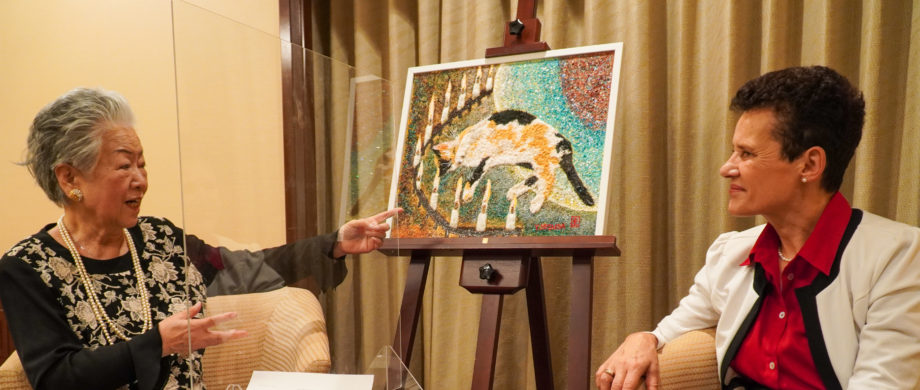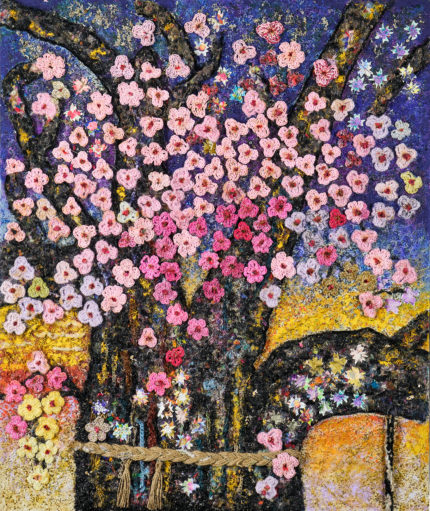- JEPAA Member

- Mixed Paint
- Keisetsu Yoshida
- 混合画
- 吉田圭雪
© 2024 Keisetsu Yoshida.
SCROLL
Portfolio /作品一覧
- 醍醐桜・御来光/Daigo cherry blossoms, Goraimitsu
- 醍醐桜/Daigo cherry blossoms
- 醍醐桜・月光/Daigo cherry blossoms, Gekko
view more
Interview article /対談記事
3 年ぶりの再会で “金色の桜” と “ターコイズの夜空” を愛でる

カトリン=スザンネ・シュミット(以下 シュミット):おひさしぶりです、吉田先生。(お会いするのは)3年ぶりですね。
吉田圭雪(以下 吉田):そうですね、時間が経つのは早いです。
シュミット:前回日本に来た時は、まさか次に日本に来るまでこんな長い時間がかかるとは思っていませんでした。やはりどんな出会いも「一期一会」ですね。一つ一つの出会いが最後になるかもしれない。今回のコロナのことで、つくづくそう思いました。話が逸れてすみません。それでは池袋展に出展されている作品について、お伺いしてもよろしいでしょうか?
吉田:こちらの作品は我が家の飼い猫を描いた作品です。その猫がいつも寝ていまして、それが愛らしくて作品にしました。
シュミット:背景がとても印象的ですね。このエメラルドグリーンの鮮やかさには、みんな目を引かれるんじゃないでしょうか。
吉田:これはターコイズフリンジです。皆既月食で月が地球の影に完全に隠れる前後に、月の縁が淡い青緑色に輝いて見える現象です。なんとか作品にしたくて、よく観察しながら仕上げました。
シュミット:ターコイズフリンジという神秘的な現象にふさわしい、幻想的な世界観が表現されていますね。
先日のパリの展覧会でも吉田先生の作品は、遠くにいても(吉田先生の作品だと)一眼でわかりました。まさに先生だけのオリジナリティを感じますね。
吉田:嬉しいです。ありがとうございます。
シュミット:こうして絵を見られるのも、今になってみるととても貴重なことだと思いますね。吉田先生はどうでしょう。制作活動は変わりなく続けられていますか?
吉田:2020 年になりますが、『醍醐桜』という大作を描きました。この絵は 3 枚の絵を繋げると一つの作品となります。モデルになっている桜は実際に真庭市(岡山県)の丘の頂上にありまして、高さが 18m もあるんですよ。
シュミット:これも神秘的な作品ですね。花の中に金色が散らされているのが見えます。
吉田:これは朝日にあたった花びらが光輝いていることを表現しています。
シュミット:それは、印象派のような発想だと思いますね。彼らは自分に見えた光をそのまま描いていました。吉田先生の目にも光が金色に輝いていたのではありませんか?
吉田:そう、そうですね。私は自宅に桜の木を植えるほど桜が大好きで、この絵の他にも桜は数多く描いています。その中でもこの作品は描くのにかなり力を使いました。3 枚構成にしたのは、朝から夜中までという桜の木の移ろいを表現したかったからです。
シュミット:素晴らしいです。一枚の大作にしなかったのが不思議でしたが、意味がきちんとあったのですね。そういえば三年前にお会いした時、吉田先生の美術館ができるというお話を伺いましたね。あれから時間が経ちましたが、その計画は実際に進められているのでしょうか?
吉田:そうですね。何年も前から弟が私の美術館を作りたいと言っていたのですが、いよいよ形になりそうです。弟は私の作品のファンなのですが、どうしても美術館を作りたいと言ってくれています。
シュミット:やはり地元に建てるのでしょうか?
吉田:今、総社市(岡山県)の元々雪舟の美術館だった場所を改築しています。地元の岡山市からは少し離れているのですが、行きたい時になんとか行ける距離です。もし完成したら、ぜひシュミットさんも来てくださいね。
シュミット:ええ、ぜひ。一日でも早く。それまでに吉田先生には、美術館に展示する作品を描いて欲しいと思います。
吉田:そうですね。お約束します。
シュミット:今はまだコロナの検査とかがあって国と国を行き来するのは大変な状況が続いていますが、これからはもっと簡単に行き来できるようになるでしょう。私は今日の対談を本当に楽しみにしておりました。それは文化交流としてそして人間的な心と心の交流ができると感じていたからです。
吉田:本当にそうですよね。ありがとうございます。
シュミット:次は吉田先生の美術館でお会いしましょう。ありがとうございました。
吉田:こちらこそありがとうございました。
(2022年特別対談 吉田圭雪×ハイケ・イェローミン)
Appreciating “Golden Cherry Blossoms” and “Turquoise Night Sky” at a Three-Year Reunion

Katrin-Susanne Schmidt: Ms. Yoshida, it’s good to see you again. The last time we met was three years ago, right?
Keisetsu Yoshida: That’s right, time sure does fly.
Schmidt: The last time I left Japan, I didn’t think it would take this long for me to come back again. I guess it’s important to treasure every meeting because you never know when it could be the last time. COVID has made me think a lot about that lately.Anyway, sorry to go off on a tangent. Could I ask you about the piece you’ve submitted forthe Ikebukuro exhibition?
Yoshida: This is a picture of our cat. He’s always sleeping, and I decided to paint him because he’s just so cute.
Schmidt: The background is really impactful. That emerald green is so vivid, it must really catch people’s eye.
Yoshida: That’s a turquoise fringe. It happens when the edge of the moon seems to appear a light green at around the time it becomes fully concealed by the Earth’s shadow during a total lunar eclipse. I really wanted to paint it, so I watched the moon closely.
Schmidt: The turquoise fringe is a mysterious phenomenon, and this is an equally wondrous perspective that expresses it. When I was at the Paris exhibition a while ago, I could immediately tell, even from a distance, which were your paintings. Your works really have a feel that’s all their own.
Yoshida: It’s nice to hear that. Thank you very much.
Schmidt: It’s so nice to be able to see paintings like this. What do you think, are you still making art in the same way you always have?
Yoshida: In 2020 I painted a big piece called “Daigo-Sakura.”It’s actually three smaller paintings put together. The model used is an actual cherry blossom tree in the city of Maniwa (in Okayama Prefecture). It’s an 18 m tall tree at the top of a hill.
Schmidt: This is a magical piece, as well. You can see the gold color sprinkled throughout the flowers.
Yoshida: That’s to show morning light playing off of the flower petals.
Schmidt: That’s a concept from Impressionism, I believe. They depicted light just as they saw it. Perhaps light shines golden in your eyes, as well?
Yoshida: It does. I like cherry blossom trees so much that I planted one in my yard, and I’ve painted many other cherry blossom paintings. But I put a lot of myself into making this painting, in particular. With the three-panel structure, I wanted to express how cherry blossom trees change from morning to night.
Schmidt: It’s amazing. I wondered why you didn’t just make it one big piece, but you had a good reason.By the way, three years ago when I last saw you, you told me that there was going to be a gallery made for your art. I know it’s been a while, but how is that coming along?
Yoshida: Since several years ago, my brother had been saying that he wanted to create a gallery for me, and now it finally looks like it’s going to take shape.As a big fan of my work, he said he definitely wants to put together a gallery.
Schmidt: Is it going to be built in your hometown, then?
Yoshida: It’s being renovated from an art gallery in Soja (Okayama Prefecture) that used to house paintings by Sesshu. It’s a bit of a distance from my hometown of Okayama, but still close enough that I can get there when I want to. I hope you’ll come by when it’s completed.
Schmidt: Absolutely! I can’t wait to go. I hope that by then you’ll be able to make some paintings to display at the new gallery.
Yoshida: Yes. I promise.
Schmidt: Travel between countries has been difficult because of things like COVID tests, but I think the situation will improve going forward. I was really looking forward to this conversation with you, for the cultural exchange aspect but also because I felt we could have a more personal heart-to-heart exchange.
Yoshida: I feel the same way. Thank you very much.
Schmidt: Next time let’s meet up at your gallery. Thank you very much.
Yoshida: The pleasure was all mine.
(Special Talk Session 2022 Keisetsu Yoshida×Katrin-Susanne Schmidt)
「慈愛の混合画家が寄せるモーツァルトへの想い」
ハイケ・イェローミン(以下、ハイケ):吉田先生とは、ウィーンの日欧宮殿芸術祭でお会いして以来ですね。今日はよろしくお願いします。今回出展いただいた作品は、先生の自画像とお聞きしました。
吉田圭雪(以下、吉田):はい、この着物も私が元々着ていたもので、私の家に今もあります。描いた時には、その着物を出して来てスケッチしました。
ハイケ:とても重厚感があって、他の作品にはない空気感がいいですね。そして、可愛らしい猫がいますね。
吉田:猫ちゃんは何匹も家で飼っていました。私が絵を描いている時に部屋へ入ってきたもので、「じゃあお前も描いてあげようか」ということで、描き足して上げました。
ハイケ:それは素敵なお話しですね。今はもう飼われていないのですか?
吉田:もうおりませんが、娘が獣医をしておりますもので、しょっちゅう動物と触れ合えるような環境ではありますね。そもそも絵を描き始めたのも、猫ちゃんを飼っていたということが大きな理由になっていまして、姑の介護をしながら猫ちゃんたちの面倒を見るという生活をしていた時、もう外出もできないし、誰も目を離せないし…という状況で、自分なりの時間を作るとするなら、絵を描くのが一番だったんです。猫ちゃんたちをモデルにして、そうすると、猫ちゃんたちの方でも理解しているのか、大人しくしていてくれるんですね。そんなところから始まった絵画なんですが、第31 回岡山県美術展に出品させていただいたら思いがけず奨励賞を受賞して、絵を描き続けることになりました。
ハイケ:お話を聞いていると、先生はいつも周囲の方のために尽くしていて、その気持ちが創作などの原動力になっているように感じられます。だからこそ、絵にも優しい精神性が出るのではないかと思います。
それにしても、吉田先生の表現というのは、本当にオリジナリティがあって、どの絵も見飽きませんね。
吉田:私の絵は、例えば人物画の顔などは、完全に日本画の描き方で、絵具も日本画用のものを使っています。今回の作品では、下地にコーヒー滓を使っています。
ハイケ:素材の選択が全く常識にとらわれていないのがいいですね。このコーヒー滓を使うという技法、テクスチャーが面白くて素晴らしいと思います。
吉田:一番描き方として多いのは、毛糸などの素材を使った混合画の方法ですね。これは、私の完全なオリジナルで、「毛糸絵『圭』」として特許申請も行いました。
ハイケ:その毛糸などの素材を使われるという発想は、どういったきっかけで生まれたのですか?
吉田:昔から編み物をやっているので、素材は身の回りにたくさんありました。ものすごく馴染みがあるものなんですね。きっかけは、毛糸の見本帳に貼り付けてあるサンプルが絵に使えないかと思いついたことで、完成した絵を毛糸会社の社長さんに差し上げたら、それ以降、私の家に使いきれないくらいの見本帳をお送りくださっているんです。
ハイケ:それは、すごいお話ですね。驚かれたでしょう。ところで編み物というのは、趣味ですか?それともお仕事で?
吉田:仕事で、編み物の指導をしています。もう56 年になりますか、色々とコンクールで賞と賞金などもいただきましたし、自分なりに研究もしていて、シェットランドレースの研修に海外まで行ったこともありました。
ハイケ:海外と言えば、吉田先生にはウィーンにも来ていただきましたが、どんな印象を持たれましたか?
吉田:実は、昔からモーツァルトが大好きで、琴を弾いたり詩を作ったりしながら、いつもモーツァルトの曲を聞いていたんです。ですから、ウィーンでモーツァルトの生家を訪ねた時には、まるで旧知の親友を訪ねたかのような気分になってしまいました。
ハイケ:モーツァルトは、オーストリア人であり私たちにとって、特別な存在です。そのように愛していただけているというのは嬉しいことですし、芸術家としてのインスピレーションになっているということは、とても素晴らしいつながりだと思います。ぜひこれからも日本とオーストリアの芸術交流で吉田先生の作品を見せてください。本日はありがとうございました。
(2019年特別対談 吉田圭雪×ハイケ・イェローミン)

“A benevolent mixed painter’s thoughts on Mozart”
Heike Jeromin (hereinafter referred to as“ Heike”):Ms. Yoshida, this is the first time I’ve seen you since we last met at the Japan-Europe Palacen Art Festival in Vienna. I’m pleased to have you today. I heard that the work you exhibited this time was a self-portrait.
Keisetsu Yoshida (hereinafter referred to as“Yoshida”): Yes. This kimono is also something that I’ve been wearing from the start, and I still have it in my house. When I was drawing it, I did a sketch while wearing that kimono.
Heike: It really has a sense of profoundness.It’s also good that it has a vibe that cannot be felt in other works. You’ve got lovely cats too, haven’t you?
Yoshida: I had many cats at home. When I was painting this piece, the cats all came into my room. So I just thought, “How about I paint you too then?” And that’s how I ended up incorporating them into the painting.
Heike: That’s a wonderful story. Are you no longer taking care of them now?
Yoshida: They’ve already passed away. But since my daughter works as a veterinarian,I’m in a position where I’m able to interact with animals on a frequent basis. The reason I started painting in the first place is also greatly attributed to the fact that I had pet cats. When I was living a life where I was taking care of my mother-in-law while looking after my cats, I wasn’t able to leave my house and I also wasn’t able to take my eyes off of anyone… So when I wanted to make time for myself, painting was the best way of doing it. I turned my cats into my models. And as I did that, my cats gave me their understanding and obediently followed along. So that’s how I started painting. But when I got to display my work at 31th OKAYAMA prefecture exhibition, my painting actually won the competition unexpectedly. So that’s how I continued painting as a result.
Heike: As I was listening to you talk, I sensed that you are always doing your best for those around you. So I felt as though those feelings have also become the driving force for your creations. That’s why I think even your paintings exude a kind spiritual nature.
Even so, your expressions are still truly original. So I never get tired of seeing any of your paintings.
Yoshida: For my paintings, things such as the faces in portraits are completely painted in the Japanese style. The paints I use are also the ones used for Japanese paintings. In my work this time around, I used coffee grounds to paint the foundation.
Heike: It’s good to select materials that are unconventional. I think that when you apply this technique of using coffee grounds, the texture would be interesting and wonderful.
Yoshida: I think the painting method I used the most was that of creating mixed paintings, in which materials such as yarn are used.This techniqe ‘yarn painting “KEI”’ is also a completely original technique of mine that I’ve even applied to have patented.
Heike: How did you come up with the idea of using materials like yarn?
Yoshida: I’ve been knitting for a long time, so there was a lot of yarn around me. It’s also a material that I’m very familiar with. So I started incorporating yarn into my paintings when I suddenly got the idea of using the samples in my yarn sample book. After I finished my first yarn painting, I gave it to the president of the yarn company. So ever since then, the company has been sending me an inexhaustible amount of yarn sample books.
Heike: That’s a great story. You must’ve been surprised. By the way, is knitting a hobby of yours? Or is it work?
Yoshida: I teach knitting as my job. I’ve been doing it for 56 years already. I’ve also received awards and prize money at various competitions, and have been doing my own personal research as well. On top of this, I’ve also gone abroad to study about Shetland lace.
Heike: Speaking of going abroad, after coming to Vienna, what sort of impression did you get from the city?
Yoshida: Actually, I’ve always loved Mozart and have always listened to Mozart’s songs while playing the koto or writing poems. So when I visited Mozart’s family home in Vienna, it felt as though I was visiting a good old friend of mine.
Heike: As an Austrian, Mozart is a special person to us. I’m happy that you love him so much. I also think that being inspired by him as an artist is a wonderful connection to have to him. With that said, I hope that you continue to show your work in the future art exchanges to come between Japan and Austria. Thank you for your time today.
(Special Talk Session 2019 Keisetsu Yoshida×Heike Jeromin)
Solo exhibition/個展
特設個展ブースin 日欧宮殿芸術祭2021
会期:2021年6月4日~6日
会場:シャルロッテンブルク宮殿(ドイツ・ベルリン)
主催:一般社団法人 日欧宮殿芸術協会
運営:クリエイト・アイエムエス株式会社
Special Exhibition Booth in JEPAA Festival 2021
Dates: June 4-6, 2021
Venue: Charlottenburg Palace, Berlin, Germany
Organizer: Japan-Europe Palace Art Association
Operated by: Create IMS Co.
Profile /経歴
吉田圭雪 Keisetsu Yoshida
1945年 岡山県在住
「混合画」特許取得
ニット工房「圭」主催
作品出展国遍歴(JEPAA関連事業):ドイツ、フランス、イタリア、カナダ他
Okayama, Japan
Patent for “KONGO-GA” drawing method
Knitting school “KEI” Organizer
Exhibition of Works(JEPAA): Germany, France, Italy, Canada…










